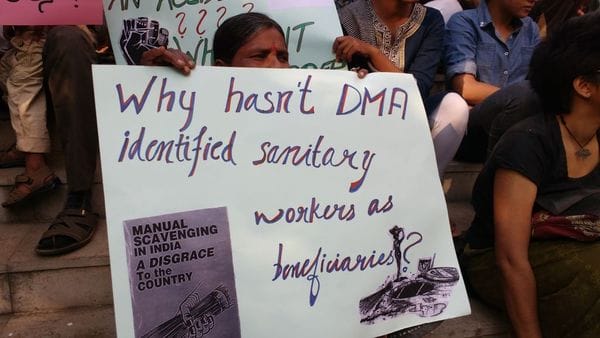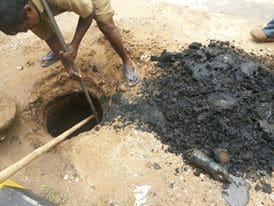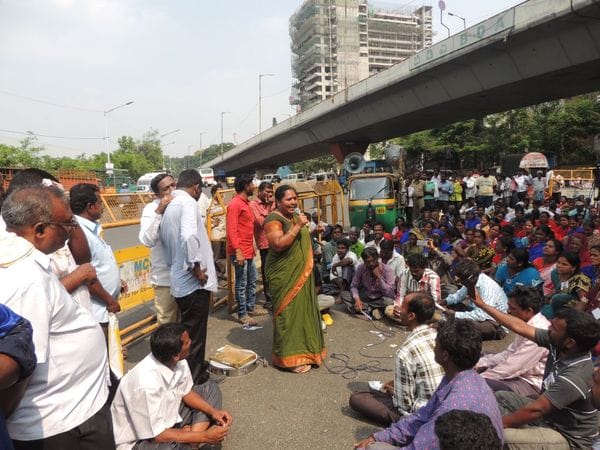
Man-hole cleaning. Pic: Thamate
Munuswamy, hailing from Dharmapuri district in Tamil Nadu, and Jagannatha, hailing from Chittor district in Andhra Pradesh, died due to asphyxiation from lack of oxygen and an excess of methane gas while cleaning up a 15-foot man-hole in Doddaballapur on April 3rd 2016. They were working for a Hyderabad-based contractor firm, Raus Construction Pvt. Ltd., who had signed an agreement with the Doddaballapur Municipal Commissioner for providing the under-ground draining system in Doddaballapur.
Seeing Munuswamy and Jagannatha suffocate, two youngsters from Doddaballapur, Madhu, a garment worker and Muniraju, an aquarium worker, tried to rescue them but it was in vain.
For Ranjan who died while cleaning a sewage treatment plant in an apartment complex in Begur, Electronics City on December 14th 2015, there were Jagadish and Mahesh who perished while trying to save him.
Similarly, for Ambarish and Narasimhamurthy who died in Yelahanka New Town in Bengaluru on November 4th 2008, there was auto-driver Srinivas who sacrificed his life.
Man-hole deaths are seldom solitary affairs.
The jaatha and the promise
On the afternoon of Thursday March 31st 2016, the Safai Karmachari Kavalu Samiti’s (SKKS) 10-day long state-wide jaatha to spread awareness on the Prohibition of Manual scavenging Act 2013 wound up in Bengaluru with more than 2000 people from all over the state converging in the capital.
Obalesh Bhemappa and several others from SKKS met the Karnataka CM, Siddaramaiah, with two key demands. One, to implement the Prohibition of Manual scavenging Act 2013, and two, a complete stop to the rampant outsourcing of sanitation work to private contractors all over Karnataka.
The 10-day state-wide jaatha to spread awareness among people and officials on manual scavenging eradication. Pic: Thamate
The Chief Minister assured that the latter issue will be tabled in a cabinet meeting very soon. He also promised to convene a meeting in April with all stake-holders, including civil-society representatives, to work towards ending manual scavenging in Karnataka.
However, these promises had been made several times in the past. They did not help save those four youngsters in Doddaballapur.
Manual scavenging – rampant and deadly
And if the man-holes don’t kill them, the job kills them. Mentally and physically. Almost all manual scavengers (and safai karmacharis) remain temporary workers on contract even after decades of service, and barely earn minimum wages. Often times, it is local officials who intruct them to clean up open defecation spots or dry latrines even while refusing to officially acknowledge the presence of manual scavenging in their localities. The extremely hazardous conditions they are exposed to takes a toll on their bodies. “Manual scavenging work ages people very quickly and most people do not live beyond their forties”, says Obalesh.
The 2011 Socio Economic and Caste Census reported that Karnataka had more than 15,000 rural manual scavengers and more than 56,000 insanitary latrines. SKSS estimates the actual number of manual scavengers to be a lot more. While the two workers who died in Doddaballapur hailed from OBC castes in TN and Andhra Pradesh, more than 95% of manual scavengers in the country are Dalits, as mentioned in the SC judgement. The occupation is often forced to run in Dalit families. Upon the demise of a manual scavenger, the job is often “given” to a youngster in the same family, even if they are barely into their teens.
Nobody seems to have a problem with this reservation policy.
Acts of wilful negligence
A fact-finding team comprising of individuals from SKKS, Alternative Law Forum (ALF), People’s Democratic Forum (PDF) and People’s Union for Civil Liberties (PUCL) visited the site of the Doddaballapur tragedy. According to their preliminary report, no government official was present when the contract workers went down into the pit for repair work. The contractor overseeing the work had forced the workers to go down into the manhole without providing them with any safety equipment like face masks; even elementary safety measures, such as keeping the manhole lid open for the gases to come out were not taken.
The team also found that the police had filed cases against the contractor under the Manual Scavengers and Construction of Dry Latrines (Prohibition) Act, 1993, the SC and ST (Prevention of Atrocities) Act 1989, and IPC Section 304 (A) (death due to negligence). It took some persuasion for similar cases to be filed on unnamed “municipal staff” too (as in mandated by the law).
The 10-day state-wide jaatha to spread awareness among people and officials on manual scavenging eradication. Pic: Rakesh Ram
The devil is in the details, they say. This has been termed a “rash or negligent act causing death, but not amounting to culpable homicide.” But these acts have resulted in 13 manual scavenging deaths in the last 13 months (and at least 45 deaths since 2008) – what would one call a “rash or negligent act” committed time and again, an illegal act no less, in full knowledge of the likely fatal consequences?
Outraged by the spate of worker deaths in man-holes and septic tanks and the continuing instances of manual scavenging in the state, several members of sanitation workers unions and various civil-society groups gathered at the District Municipal Adminstration (DMA) office on April 7th, demanding immediate investigation by the Department of Municipal Adminisration (under which all urban municipal bodies come) and appropriate action against the municipal officials responsible for the Doddaballapur deaths. In specific, they demanded a case of death caused by “wilful negligence” not amounting to culpable homicide (304-Part 2, which is a non-bailable offence, as opposed to 304(A) which is bailable) be filed against the contractor and the municipal officials.
Rather revealingly, Obalesh remarked that several of the DMA staff had no idea about these acts and judgments when they made their representation to the DMA Joint Commissioner.
One-time financial compensation in lieu of justice
On April 11th, the families of all four victims received cheques for Rs 10 lakh each as compensation (as per the Supreme Court judgment). This has typically been the case with almost all other manual scavenging deaths in the last few years. Conspicuous in its absence though, is any sign of a rehabilitation package for the Doddaballapur victim’s families.

Protest in front of District Municipal Administration building on Apr 7th. Pic: Karthik Ranganathan
As per the 2013 Act, any identified manual scavenger needs to be provided a one-time financial assistance, housing allotment, alternative livelihood and educational scholarship for their children in a timely manner. This would make all victims of manual scavenging deaths also eligible for the same, but it has been an uphill struggle to avail the same.
A recent Karnataka High Court judgement (WP 163365 of 2014, Jan 11th 2016) provided the first instance in the state of a manual scavenging victim’s family being awarded all the rehabilitation benefits due to them from the state, under Section 13 of this Act. But Advocate Maitreyi Krishnan who represented the petitoners in that case says that the petitioners are yet to get the financial compensation and the rehabilitation benefits. It remains to be seen as to how long it will take for the Doddaballapur victims’ families to receive these benefits.
Punishment for the culprits, be it the contractors or the concerned municipal officials has been one step too far though.
The buck stops at the district magistrate’s desk
The employment of contract workers for cleaning sewerage pipes without protective equipment resulting in the deaths from asphyxiation due to sewer gas, is a clear violation of sections 5, 6 and 7 of the Prohibition of Manual Scavenging Act 2013 and of the 2014 Supreme Court judgment for the writ petition filed by the Safai Karmachari Andolan.
Section 18 of the 2013 Act also states that it is the duty of the District Magistrate and any other subordinate officers authorised, to ensure that nobody is engaged or employed as a manual scavenger within their jurisdiction. It is clear that the FIR registered in the Doddaballapur police station has to name the local District Magistrate as the main accused, instead of unnamed “municipal officials”, as is the case currently.
According to Obalesh, this is the norm and that in all the cases of manual-scavenging deaths till now, those named in the FIRs have only been low-level officials, instead of those at the top. Moreover, none of those named in those FIRs have been convicted till now.
However, the violations of the 2013 Act by the Karnataka state form a much longer list.

Protest in front of District Municipal Administration building on Apr 7th. Pic: Karthik Ranganathan
A law observed more in breach
The act required local authorities to conduct surveys to identify insanitary latrines and get them replaced with sanitary latrines. It also required them to conduct surveys to identity manual scavengers, and rehabilitate them. According to SKKS, the Karnataka state government is yet to conduct a single survey along these lines.
To make things worse, a total of 302 people who had been registered as manual scavengers after self-identification even before the 2013 act was passed, are yet to be rehabilitated fully. While less than half of them have received a one-time financial assistance of Rs 42,000, the others are yet to be paid, apparently due to ineligibility on various counts (no bank accounts, no proper identification etc). None of them have received any of the other benefits due to them.
However, the lack of rehabilitation is not entirely due to lack of funds being available at the State level. Obalesh reveals that the Dr BR Ambedkar Development Corporation (ADC) which is responsible for providing financial assistance to manual scavengers in Karnataka, reached out to SKKS in 2014 for suggestions on how to proceed, having received Rs 3 crores from the Central government for this purpose. Despite suggestions from SKKS, the money is yet to be disbursed to the intended beneficiaries, even after two years.
Institutional indifference
Perhaps the most damning violation of the 2013 act is the extremely tardy response to the requirement of setting up “Vigilance Committees” for each district and each sub-division as mandated by Section 24. Most crucially, it is the function of these committees to oversee the economic and social rehabilitation of manual scavengers and to monitor the registration of offences under this act and their investigation and prosecution.
That is, if and when they are constituted.
Responses to Obalesh’s RTI request on this issue confirmed that several districts did not have a single committee constituted. Many districts including Mysore, Bijapur and Bidar provided no information on the status of these committees at the district level. Most damningly, even the Bangalore Urban District has not responded.
Admittedly, sub-divisional vigilance committees have been formed in some places, including Mysore and Madhugiri. However, it is most instructive to listen to Obalesh’s account about the Madhugiri committee. “The Madhugiri committee was formed in 2014, and promptly convened a meeting with local stakeholders and NGOs within a few months (Obalesh was an attendee). Notably though, the chair-person at the sub-divisional level, the Assistant Collector Ms. Anita Lakshmi was absent from the meeting. However, her name did show up in the official record of the meeting as an attendee. Most importantly though, that was the first and last meeting for that committee.”
Bureaucratic redux – history repeats itself
The bureaucratic indifference in response to the 2013 Act is unsurprisingly similar to the response to the “National Scheme for Liberation and Rehabilitation of Scavengers and their dependents”, a centrally sponsored scheme implemented in 1989-90. An evaluation report submitted by the Comptroller and Auditor General (CAG) in 2003 remarked that the scheme had failed to realise its objectives even after 10 years of implementation.
Despite involving investment of more than Rs 600 crores, much of the fund available for the scheme remained unspent or underutilised. The committees setup for monitoring the scheme were non-functional and that “there was no evidence to suggest if those liberated were in fact rehabilitated”. And to round things off, the report concluded that “the most serious lapse in the conceptualisation and operationalisation of the scheme was its failure to employ the law that prohibited the occupation… the law was rarely used.”
The more the laws change, the more the ground-reality remains the same.
Casteism – intrinsic and institutionalised
“The ministers and other officials come here for a few minutes, wear gloves, caps and take photos holding brooms. They are not even concerned that we, who clean the neighborhoods daily don’t have gloves or masks, and have to spend our own money to buy brooms”, said Manju, a safai karmachari working in Bangalore.

In the absence of relevant machines in Bengaluru, the workers are forced to get into the hole to clean it. Pic: Shree D N
“The officials in Bellary don’t even treat us as humans. If we demand what is due to us, they order our names to be struck off the rolls immediately. It breaks my heart to see our people continue to do this job”, said a visibly distressed Nageshanna, a safai karmachari from Bellary participating in the jaatha.
It is casteism that rendered certain communities as “unclean” and “untouchable” several hundred years ago to force them to take up everybody’s sanitary work. It is that same casteism that makes us wonder as to who will clean the man-holes and septic tanks if “they” don’t do it.
Casteism has ensured that “post-modern India” which is capable of sending space shuttles into Mars’ orbit is incapable of implementing technology to eradicate manual scavenging in houses, sewer-pipes and railway lines. It is so inured in our society that even six years after the day when 10 manual scavengers in Savanur taluk, Haveri Zilla, Karnataka, smeared themselves with human excreta to protect their houses, they still struggle to break out of this dehumanising occupation, let alone secure permanent jobs, minimum wages or housing rights. Casteism is so institutionalised in our bureaucracy that manual scavenging even ends up a career option in the National Career Services website launched by the Central government in 2015.
“All throughout the jaatha, we kept hearing that not once have the workers been offered water, or even a kind word, in the neighborhoods they clean daily. Basic decency and humanity should have made the residents of Bengaluru turn up for this jaatha, in support of those very people”, said Dr Chandrasekara, Professor, Kannada University, Hampi.
“There is no humanity” – Dr. Chandrasekhara’s words should make all of us sit up and introspect.
“Swachh Bharat” cannot coexist with manual scavenging
The twin demands of eradicating manual scavenging and rehabilitating manual scavengers are eminently feasible with the technology available on hand and the infrastructure and resources allocated as per government policies. The need of the hour is an immediate rejection of the institutional and societal mindset which believes that this has been the “traditional” occupation of the “untouchable” castes and that they will continue to do it.
“We will make sure our kids get educated. We will make sure our kids will not do this work. It has to stop with us”, asserted Nageshanna.
It’s high time the State and Central Governments and the dominant castes in our society ensured they are not forced into it.
It’s not just illegal. It’s inhuman. It’s about time the machines took over the task.

